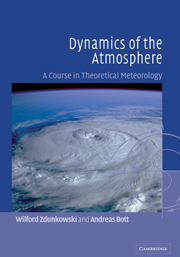Book contents
- Frontmatter
- Contents
- Preface
- Part 1 Mathematical tools
- M1 Algebra of vectors
- M2 Vector functions
- M3 Differential relations
- M4 Coordinate transformations
- M5 The method of covariant differentiation
- M6 Integral operations
- M7 Introduction to the concepts of nonlinear dynamics
- Part 2 Dynamics of the atmosphere
- Answers to Problems
- List of frequently used symbols
- References and bibliography
- Index
M5 - The method of covariant differentiation
Published online by Cambridge University Press: 05 June 2012
- Frontmatter
- Contents
- Preface
- Part 1 Mathematical tools
- M1 Algebra of vectors
- M2 Vector functions
- M3 Differential relations
- M4 Coordinate transformations
- M5 The method of covariant differentiation
- M6 Integral operations
- M7 Introduction to the concepts of nonlinear dynamics
- Part 2 Dynamics of the atmosphere
- Answers to Problems
- List of frequently used symbols
- References and bibliography
- Index
Summary
The numerical investigation of specific meteorological problems requires the selection of a suitable coordinate system. In many cases the best choice is quite obvious. Attempts to use the same coordinate system for entirely different geometries usually introduce additional mathematical complexities, which should be avoided. For example, it is immediately apparent that the rectangular Cartesian system is not well suited for the treatment of problems with spherical symmetry. The inspection of the metric fundamental quantities gij or gij and their derivatives helps to decide which coordinate system is best suited for the solution of a particular problem. The study of the motion in irregular terrain may require a terrain-following coordinate system. However, it is not clear from the beginning whether the motion is best described in terms of covariant or contravariant measure numbers.
From the thermo-hydrodynamic system of equations, consisting of the dynamic equations, the continuity equation, the heat equation, and the equation of state, we will direct our attention mostly to the equation of motion using covariant and contravariant measure numbers. We will also briefly derive the continuity equation in general coordinates. In addition we will derive the equation of motion using physical measure numbers of the velocity components if the curvilinear coordinate lines are orthogonal.
In order to proceed efficiently, it is best to extend the tensor-analytical treatment presented in the previous chapters by introducing the method of covariant differentiation.
- Type
- Chapter
- Information
- Dynamics of the AtmosphereA Course in Theoretical Meteorology, pp. 75 - 83Publisher: Cambridge University PressPrint publication year: 2003



